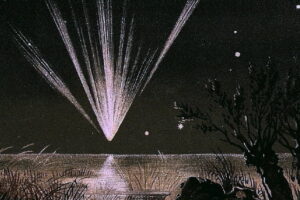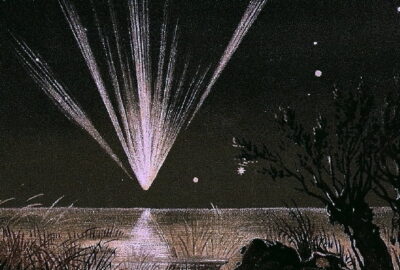The Study of Cycles
Authored by Guy Beaujouan (1961)
Translated from L’Histoire et ses Méthodes
(Vol.XI of the Encyclopédie de la Pléide)
Contents
Introduction
Even reduced to a succession of years and days, historical time is not homogeneous: with its seasonal peculiarities and peak hours, it obeys cyclical movements that strongly influence the course of life. But are we sure to recognize all the physical, climatic, geological, or biological phenomena whose regular fluctuations rhythm the evolution of human communities? The question must be asked, and it is precisely to attempt to answer it without any preconceived idea that a ‘Foundation for the Study of Cycles‘ was established in New York. This organization has endeavored to promote and publish in its Journal of Cycle Research the most seemingly disparate studies. Thus, phases of 6 years have been proposed for the price of cotton, 17 years and 9 months for that of iron, 700 years for annual climate types, 6 years for salmon abundance, and 35.2 years for earthquakes in China. Furthermore, some authors have not hesitated to establish global indices to translate the frequency of revolutions and international conflicts into a curve (a basic period of 11.2 years has been mentioned in this regard).
However questionable the results of such studies may be, they have, at least, the merit of showing how simplistic the notion of phases A and B is, as advocated by the followers of François Simiand. They suggest a renewed conception of causality and time in which the (cyclical or accidental) modifications of the physical world reclaim their true place within history itself.
Climate Fluctuations
If it is indisputable, for example, that significant climatic fluctuations have occurred during the great geological epochs, it is infinitely probable that they have not ceased at the threshold of history, even if, due to a lack of sufficient hindsight, contemporaries were not clearly aware of them (this is notably the case of the extraordinary warming that characterizes, according to specialists, the end of the 19th century and the beginning of the 20th). Several scientific theories claim to account for climate changes, but most of them involve variations spanning thousands of years (cycles of 21,000 years for the precession of the equinoxes, 40,000 years for the obliquity of the ecliptic, 92,000 years for the eccentricity of the Earth’s orbit), or very specific conditions for which history provides practically no examples (formation of mountains, changes in the atmospheric carbon dioxide content, changes in the geographical distribution between oceans and continents, etc.). Apart from questionable influences, there are therefore only four factors that can be considered: volcanic eruptions, oceanic transgressions, solar activity, and interstellar dust.
Following certain major volcanic eruptions, dust particles ejected into the upper atmosphere sometimes filter solar radiation for several years, causing a decrease in the earth’s surface heat by 15 to 20%: this explains the low temperatures of the years 1784-86, 1816, 1884-86, 1912-13.
The theory of oceanic transgressions was proposed at the end of the last century by the eminent Swedish oceanographer O. Pettersson. As is well known, each year, both in the Atlantic and the Pacific, warm waters of tropical origin (which, let us recall, are the heaviest because they contain in solution a greater quantity of salt) momentarily encroach, without mixing, on the cold waters of polar origin. They notably surge onto the coasts of Western Europe, where they soften the climate, constituting what was formerly, very inaccurately, known as the Gulf Stream. According to Pettersson, these immense tidal movements also depend on the relative positions of the Sun and the Moon: they would reach their maximum when the apogee and one of the nodes of the lunar orbit meet in a cis position at the time of the Earth’s perihelion and at the time of the winter solstice. Thus, a cosmic periodicity of approximately 1850 years is defined. The last maximum is said to have occurred around 1433, accumulating extraordinary catastrophes in the 14th and 15th centuries: the absolute force of the tides would then have caused terrible devastation on the coasts of the North Sea and the Baltic Sea; the tropical waters would have risen to such northern latitudes that they would have eroded the ice sheet: the countless icebergs thus released are said to have drifted southward, cutting off communications between Norway and Iceland, and even deteriorating the weather conditions of Western Europe.
Pettersson’s theories have been taken up and developed, not without audacity, by Ed. Le Danois in a curious book entitled The Rhythm of Climates in the History of the Earth and Humanity (Paris, 1950). The author attributes particular importance to transgressions that occur every 111 years, but whose influence, according to him, is felt differently, depending on the case, during one, two, or three Saros periods of 18 years each.
Based on these (perhaps debatable) theoretical principles and admitting that, ‘in general, the secular maxima of oceanic transgressions and the accompanying Saros periods correspond to happy times when the climate was pleasant and life easy’, Ed. Le Danois has not hesitated to subject the entire history of France to this curious climatic rhythm. His attempt sometimes raises a smile because, too often, it seeks to frame only idealized images. Oceanic transgressions nevertheless remain, along with solar activity, one of the main factors capable of renewing a cyclical conception of historical time.
Solar Activity Cycles
According to the latest research by Mr. Alexandre Dauvillier, as presented to the Academy of Sciences on March 31, 1958, ‘solar activity is due to the combination of the two residual mechanical effects of the formation of the solar system. These are surface rotation and oscillation along an axis normal to that of rotation, with twin planets being emitted at a rate of 22 years, the period of this residual oscillation. Activity is a phenomenon not internal but superficial, originating every 11 years at the poles and drifting over 22 years to ± 10°.’
The main manifestation of solar activity is the appearance of sunspots: powerful magnetic poles, they act as true particle accelerators. Electrons and positive ions projected to the surface of the earth are thus the cause of various electromagnetic disturbances which are capable of periodically influencing meteorology, crops, epidemics, crowd psychology, and consequently the course of history.
Solar activity is numerically represented by an index, known as the Wolf-Wôlfer index, which is roughly proportional to the total area of observable sunspots. The curve showing the variation of this index over time since 1750 exhibits very marked but also very uneven maxima, occurring approximately every 11 years, a period that must be doubled to account for the magnetic polarity of sunspots.
This rhythm tends to accelerate when solar activity intensifies and to slow down when it weakens. The intervals between two maxima average 11.1 years (there are 9 per century), but they can vary from 8 to 16 years, with minima preceding maxima by 4 to 6 years. Although the existence of a secondary cycle of 78 years has been recognized, these considerations do not allow for the derivation of a purely mathematical law. Therefore, the prediction of solar activity is still relatively uncertain; its determination for past centuries would be just as uncertain if history did not come, for once, to the aid of astronomy.
The Wolf-Wôlfer curve begins with the year 1750, but Wolf’s notes date back to 1700. Furthermore, there are quite a few scholarly observations since 1610, when the then revolutionary use of an astronomical telescope allowed Galileo, Fabricius, and Father Scheiner to officially discover sunspots.
Before 1610, the idea that spots could periodically appear on the sun was a priori rejected by science, as it contradicted the Aristotelian dogma of the incorruptibility of celestial bodies. Sunspots visible to the naked eye were therefore seriously observed only by astronomers in the Far East, as early as ~ 28. For example, a Korean work, the Korynsa, provides a list of sunspots for the years 1024 to 1383 AD.
Such documentation is inevitably very disjointed; however, it is possible to supplement its gaps. It is known that by ionizing the rarefied gases of the upper atmosphere (similar to an electric current in a neon tube), the particle radiation from the sun causes auroras whose frequency and intensity are therefore characteristic symptoms of solar activity.
Such luminous displays are frequently reported by medieval chroniclers who often see the sky burning or opening, rain of blood, dragons flying or fighting. By systematically recording and intelligently interpreting these alleged wonders, it is possible to supplement the Wolf-Wôlfer curve and extend it back to ~ 200. This is the method advocated by H. Fritz since 1880 and currently being implemented by an international team led by the English astronomer Justin Schove.
The enterprise is known, to the initiated, as the Spectrum of Time. It aims to characterize and chronologically classify all natural phenomena mentioned in the most diverse narrative sources (Japanese, Chinese, Arab, or European), whether sunspots, auroras, eclipses, comets, shooting stars, earthquakes, meteorological anomalies, insect invasions, epidemics, or famines.

In ancient texts, these unusual phenomena often merge (auroras with comets or eclipses with sunspots); fortunately, some of them can be dated by calculation (such as eclipses or periodic comets like Halley’s), while others may have been observed at very different points on Earth: apparently disparate facts then corroborate each other (as is the case, for example, with miraculous fish catches and oceanic transgressions, or with sunspots in the East and blood rains in the West). Moreover, many prodigies attested in legendary tales, in the lives of saints, and even in the Bible itself, can be traced back to natural phenomena that can be dated with the greatest precision.
But the Spectrum of Time is not merely a compilation of singularities of the physical or biological world, as recorded by chronicles or archives: it seeks to expand by using techniques dear to geologists and prehistorians (analysis of pollen translating variations in flora, study of recurrence surfaces in bogs, especially of glacial varves, and recourse to dendrochronology).
As is known, it was the American A. E. Douglass who first thought of studying the relative thickness of concentric circles of annual growth forming the trunk of very old trees to determine the climatic evolution of the Southwest United States. He was thus able to establish a typical pattern that he gradually extended up to thirteen centuries for the Pinus silvestris and up to 3250 years for the giant sequoias of California.
But these remarkable results initially aroused overly ambitious hopes: it was believed that the succession of growth rings followed an 11-year periodicity reflecting that of solar activity itself (there was difficulty for the 17th century, but the low solar activity at that time seemed to account for it). It therefore seemed natural to imagine that the diagrams established for American tree trunks would allow the dating of old European woods.
There is little left today of these attractive prospects: tree growth is stimulated in Arizona by wet years and in Scandinavia by hot summers: the coincidences can only be fortuitous. The results obtained so far are nonetheless extremely interesting, especially regarding the Nordic countries, because, as is known, the higher the latitude of a region, the more characteristic are its climate changes (the advance or retreat of glaciation being both the symptom and the secondary cause).
The indications provided by dendrochronology can also be supplemented by the phenological method. It is known that the maturity of fruits is the earlier the warmer and sunnier the period between bud burst and full fruiting. Thus, curves of spring and summer temperatures have been established by noting, for each year, the date of grape harvests in certain French vineyards or the date of cherry blossom in certain Japanese provinces. Here again, roughly decennial periodicities appear, but without a clear correlation with solar activity cycles.
How can we be surprised by this? Indeed, while specialists are nearly unanimous in recognizing that variations in solar activity exert a great influence on meteorological conditions, they have great difficulty determining the details. Abbot tried to establish that during solar activity maxima, the Earth experiences a clear increase in stormy phenomena and receives about
a 2% heat supplement. But this variation in the ‘solar constant’ has been contested, and it has even been claimed, by Brooks, that such a heat supplement would actually lower temperatures by increasing cloudiness.
It is commonly accepted, however, that solar eruptions increase atmospheric pressure where it is generally high and weaken it where it is generally low: they thus seem to favor the extension of continental anticyclones with blocking of oceanic disturbances and meridional invasions of air masses intensified from subtropical or Arctic origins. In these conditions, the failure of statistical studies on average annual temperatures of too vast regions is understandable; however, it is not surprising, for example, to see the epochs of intense solar activity characterized by reduced rainfall in Switzerland and by great variability in winter temperatures in Holland and Bohemia.
Weather & Economic Conditions
Historians increasingly readily admit that until the end of the 18th century, meteorological conditions had a powerful influence on the lives of societies primarily agricultural and constantly concerned with the perennially challenging issue of sustenance. While economic and demographic factors partly depend on historical events, climatic fluctuations, on the other hand, are a kind of primary cause whose importance it is quite tempting to exaggerate.
How can one resist the temptation to attribute to a certain warming of the climate the northward shift of the center of gravity of European civilization in the High Middle Ages? Does this theory not seem corroborated by the intensity of the traffic experienced then in the Alpine passes and by the very northern latitude of certain maritime routes frequented by the Normans?
Likewise, how can one not fully exploit, even if its scientific foundations are fragile, Pettersson’s theory, which explains the deterioration of the European climate in the 14th and 15th centuries, that is, during the period of economic and demographic regression that marks the end of the Middle Ages, by the excess of the “tidal generating force”?
Messrs. Braudel and Utterstrom experienced similar temptations regarding the crisis of the 17th century. Indeed, no one contests that around 1600, there was a clear counter-offensive of glaciers, both in the Alps and in Iceland: this marks the beginning of what English meteorologists now commonly call the Little Ice Age. A high proportion of harsh winters between 1540 and 1600 would, according to Dr. Schove, be the cause of this “little ice age” which would extend until the second half of the 19th century. Unfortunately, this very interesting observation loses much of its value when examined more closely. Climatologists attempt to characterize, for each year, the winter and the vegetative period: nothing allows us to assert a priori the existence of a correlation between these two series. According to a concept dear to Mr. Braudel, one must revert from the “long term” to the “short term.” One can then observe, with E. Leroy-Ladurie, that for France, from 1646 to 1651, six continuously rainy years are the origin of the economic and social unrest that awkwardly expressed itself in the Fronde revolts. Furthermore, still for France, the phenological method allows us to contrast the warm vegetative periods of the years 1652-1687 with the rather cool springs and summers of the years 1687-1717.

With less abundant and more expensive sustenance, we find ourselves at the very heart of the difficulties that accumulate in the second half of the reign of Louis XIV. How can one contest the legitimacy of such a comparison when acknowledging, for the 18th century, the curious parallelism observed by E. Leroy-Ladurie between the phenological curve and that of the price of wheat: the colder the vegetative period and consequently the later the grape harvest, the higher the price of cereals; however, no correlation appears with the eleven-year cycles of solar activity. We are therefore far from the grand cosmic rhythms whose cadence we would have liked to rediscover in the very heartbeat of history.

Today, science offers us only rather fragile theories, and scholarship provides us with still too few observations: these theories and observations do not align very well, but an immense amount of work remains to be done.
Psycho-Physiological Phenomena
Since 1934, two American economists, Carlos Garcia Mata and Felix I. Shaffner, also compared fluctuations in solar activity with those in the economic life of the United States. To their great surprise, they found, as we have just seen for France in the seventeenth and eighteenth centuries, that their attempt was doomed to failure regarding agriculture. ‘On the contrary,’ they wrote, ‘we can assert that, from a purely statistical point of view, there is a clear correlation between non-agricultural economic activity cycles in the U.S.A. and 11-year solar cycles. However, we have not succeeded in determining whether it was preferable to take into consideration either the total solar disturbances with a lag of several years or a secondary cycle reflecting the annual increase or decrease of spots and faculae.’ Our authors therefore began to wonder if the influence of solar activity was not primarily felt, in business, through storms under the skulls, or ‘brain storms.’

They even considered, from this curious point of view, several stock market panics. A scholar as scrupulous as Dr. Schove does not hesitate to draw attention to ‘a curious coincidence between revolutions and solar spots: 1789, 1830, 1848, 1870, 1906, 1958 coincide with the peak of solar activity.’ One might be tempted to add that ‘classical’ centuries like the 13th and the 17th are characterized, on the contrary, by a remarkable weakening of this phenomenon. As fantastic as such perspectives may be, they can stimulate historical critique effectively. For example, it is known that the Soviet researcher Tchijevsky discovered a very clear correspondence between solar activity peaks and the actual rise of cholera pandemics. Less striking but still remarkable correlations have been established, with varying offsets or the use of mirrored curves, between Wolf-Wolfer indices and the severity of certain epidemics (diphtheria, relapsing fever, influenza, plague, cerebrospinal meningitis, etc.). These facts do not seem random: indeed, it is observed in the laboratory that the action of a magnetic field and ion bombardment, depending on their intensity, activate or inhibit microbial culture proliferation. Solar activity fluctuations may also influence the very terrain of disease, the human body: this observation supports the suggestions previously made in the field of collective psychology.
Conclusion
Just as today’s science no longer satisfies itself with purely conceptual time independent of physical reality, history also attempts to renew its fundamental concepts. Instead of the taut thread of classical chronology, it substitutes a sort of tempestuous mare magnum, whose tumultuous agitation may perhaps conceal the interference of multiple regular fluctuations. The determination of these rhythms can, in our view, hope for much from purely scientific research, such as those undertaken during the International Geophysical Year.
But the historian should not allow himself to dismiss the demands of traditional criticism on the basis of these promises. First and foremost, he will refrain from despising his sources in the name of hasty rationalism. He will no longer reproach the ancient annalists for relating with the same insistence both the rain and the fair weather as well as the supposed historical events. He will also hesitate to mock the chroniclers who claimed that ‘signs’ appearing in the sky heralded great epidemics, for he will wonder if he should not see in them two symptomatic manifestations of a maximum in solar activity according to Tchijevsky’s theories.
Serial history therefore does not exempt one from establishing the facts correctly and dating them precisely: the techniques of traditional chronology retain, more than ever, all their value.
Bibliography
- Philippe ARIÈS, The Time of History, Monaco, 1954.
- Fernand BRAUDEL, History and Social Sciences: the long term, in “Annales”, XIII, pp. 725-753, 1958.
- C. E. P. BROOKS, Climate through the Ages: a Study of Climatic Factors and their Variations, London, 1950.
- Climatic Changes: Evidence, Causes and Effects, Proceedings of a symposium edited by Harlow SHAPLEY, Harvard, 1953.
- Carlos GARCIA MATA and Felix I. SHAFFNER, Solar and Economic Relationships, in “Quarterly Journal of Economics“, LXIX, 1934; reissued in New York by the “Foundation for the Study of Cycles“, 1945.
- Emmanuel LEROY-LADURIE, History and Climate, in “Annales”, XIV, pp. 3-34, 1959.
A. L. TCHIJEVSKY, Epidemics and Electromagnetic Disturbances of the External Environment, Paris, 1938. - Current bibliography in “Meteorological Abstracts“, since 1950.
I must thank the distinguished English climatologist Justin SCHOVE for his assistance, who is currently preparing an important work entitled Spectrum of Time. The works of this author should all be mentioned here; among the most recent ones:
- Justin SCHOVE, The Sunspot Cycle, 649 B.C. to A.D. 2000, in “Journal of Geophysical Research”, LX, pp. 127-146, 1955.
- Justin SCHOVE, and A. W. G. LOWTER, Tree Rings and Medieval Archaeology, in “Medieval Archaeology”, I, pp. 78-95, 1957.







